How to make inverters (converters) 12-220 V
To connect household appliances to the on-board electrical system of a car, an inverter is required, which can increase the voltage from 12 V to 220 V. They are in sufficient quantities on store shelves, but their price is not happy. For those who are a little familiar with electrical engineering, it is possible to assemble a 12 220 volt voltage converter with your own hands. We will analyze two simple schemes.
The content of the article
Converters and their types
There are three types of converters 12-220 V. The first is that 220 V is obtained from 12 V. Such inverters are popular with motorists: through them you can connect standard devices - TVs, vacuum cleaners, etc. The reverse conversion - from 220 V to 12 - is required infrequently, usually in rooms with severe operating conditions (high humidity) to ensure electrical safety. For example, in steam rooms, swimming pools or bathrooms. In order not to risk it, the standard voltage of 220 V is lowered to 12 using appropriate equipment.
The third option is, rather, a stabilizer based on two converters. First, the standard 220V is converted to 12V, then back to 220V. This double conversion allows you to have a perfect sine wave at the output. Such devices are essential for the normal operation of most electronic household appliances. Anyway, when installing gas boiler it is strongly advised to power it through such a converter - its electronics are very sensitive to the quality of the power supply, and replacing the control board costs about half the boiler.
Switching converter 12-220V to 300 W
This circuit is simple, the parts are available, most of them can be removed from the power supply for the computer or bought from any radio engineering store. The advantage of the circuit is simplicity of implementation, the disadvantage is an imperfect sine wave at the output and a frequency higher than the standard 50 Hz. That is, devices that require power supply cannot be connected to this converter. Not very sensitive devices can be connected directly to the output - incandescent lamps, iron, soldering iron, phone charger, etc.
The presented circuit in normal mode produces 1.5 A or pulls a load of 300 W, to a maximum of 2.5 A, but in this mode the transistors will noticeably warm up.
The circuit is built on the popular TLT494 PWM controller. Field-effect transistors Q1 Q2 should be placed on radiators, preferably separate. When installing on one heat sink, place an insulating gasket under the transistors. Instead of the IRFZ244 shown in the diagram, you can use IRFZ46 or RFZ48 with similar characteristics.
The frequency in this 12 V to 220 V converter is set by the resistor R1 and the capacitor C2. The ratings may differ slightly from those indicated in the diagram. If you have an old non-working bezopochnik for a computer, and in it there is a working output transformer, you can put it in the circuit. If the transformer is inoperative, remove the ferrite ring from it and wind the windings with copper wire 0.6 mm in diameter. First, the primary winding is wound - 10 turns with an output from the middle, then, on top - 80 turns of the secondary.
As already mentioned, such a 12-220 V voltage converter can only work with a load that is insensitive to the quality of the power supply. To be able to connect more demanding devices, a rectifier is installed at the output, at the output of which the voltage is close to normal (diagram below).
High frequency diodes of the HER307 type are indicated in the diagram, but they can be replaced with the FR207 or FR107 series. It is advisable to select the capacities of the indicated value.
Inverter on a chip
This voltage converter 12-220 V is assembled on the basis of a specialized microcircuit KR1211EU1. This is a generator of pulses, which are taken from outputs 6 and 4. The pulses are antiphase, there is a small time interval between them - to exclude the simultaneous opening of both keys. The microcircuit is powered by a voltage of 9.5 V, which is set by a parametric stabilizer on a D814V Zener diode.
Also in the circuit there are two field-effect transistors of increased power - IRL2505 (VT1 and VT2). They have a very low resistance of the open output channel - about 0.008 Ohm, which is comparable to the resistance of a mechanical switch. Permissible direct current - up to 104 A, pulse - up to 360 A. Similar characteristics actually allow you to get 220 V at a load of up to 400 W. It is necessary to install transistors on radiators (with power up to 200 W it is possible without them).
The pulse frequency depends on the parameters of the resistor R1 and the capacitor C1, at the output capacitor C6 is installed to suppress high-frequency surges.
It is better to take the transformer ready-made. In the circuit, it turns on the other way around - the low-voltage secondary winding serves as the primary, and the voltage is removed from the high-voltage secondary.
Possible replacements in the element base:
- The Zener diode D814V indicated in the circuit can be replaced by any one that produces 8-10 V. For example, KS 182, KS 191, KS 210.
- If there are no capacitors C4 and C5 of type K50-35 for 1000 uF, you can take four 5000 uF or 4700 uF and connect them in parallel,
- Instead of an imported C3 220m capacitor, you can supply a domestic one of any type at 100-500 uF and a voltage of at least 10 V.
- Any transformer with a power from 10 W to 1000 W, but its power must be at least twice the planned load.
When installing circuits for connecting a transformer, transistors and connecting to a 12 V source, large cross-section wires must be used - the current here can reach high values (with a power of 400 W up to 40 A).
Inverter with pure sine output
Data converter circuits are complicated even for experienced radio amateurs, so making them yourself is not at all easy. An example of the simplest circuit is below.
In this case, it is easier to assemble such a converter from ready-made boards. How - see the video.
The next video describes how to assemble a 220 volt pure sine converter. Only the input voltage is not 12 V, but 24 V.
And this video just tells how you can change the input voltage, but get the required 220 V at the output.

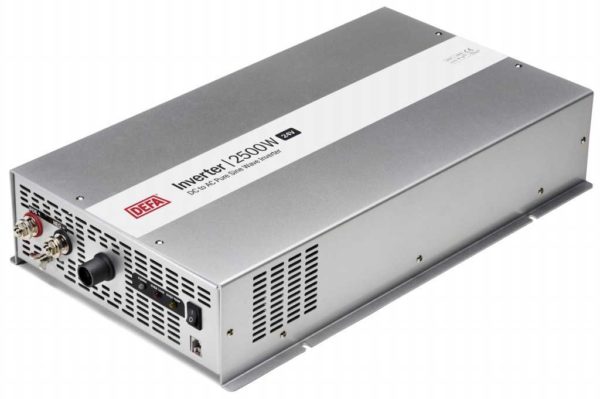
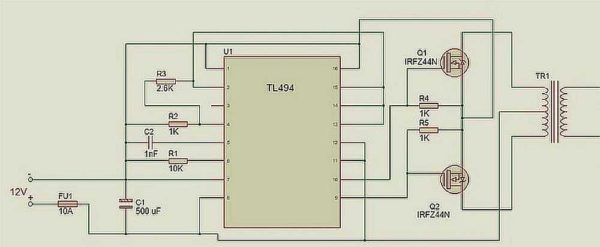

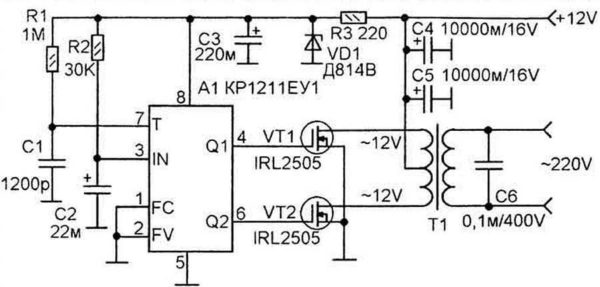
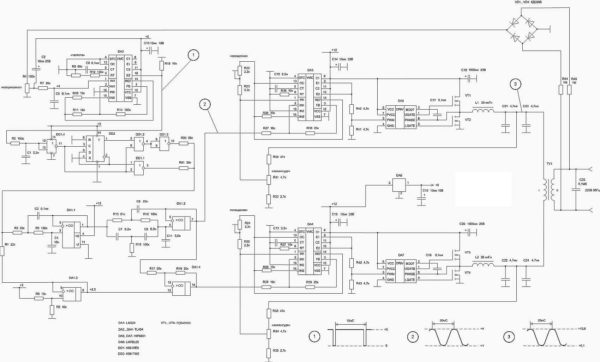
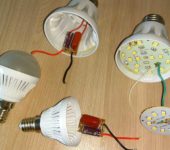


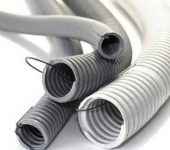
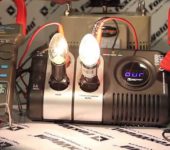





YOU ARE NOT AT ALL IN ADEKVAT TO CONNECT IN THE INVERTER CIRCUIT OF 3 POWER SUPPLIES FOR 120 V ACCELERATING TO 380 THEY ARE NOT BATTERIES AND SUCH X .. IT'S PROBABLY UNDER LOAD TO RENT A HOME TRANSMISSION UP TO 380 V FOR A SUPPLY
At 300 494 flies tell me the reason
what the hell to do - would have bought it better for 1000 rubles. a normal inverter ... I have been traveling for 8 years with a purchased 150 W inverter - enough for a laptop, telephone, mosquito fumigator, etc. trifle ... You need more powerful - the price is not terrible
You can ride for another 80 years ... If fate permits ... But know that everyone "goes crazy in their own way" Someone - to buy and ride, and someone to do it yourself ... And let my craft be not so beautifully decorated, but having 45 years of experience radio engineering, it will be "for me" ... And for me ... If you understand.
There is probably more a question of psychology.With the advent of a huge number of cheap Chinese electronics, the special need to do something with your own hands has disappeared. In Soviet times, many schools had radio electronics circles, but now they probably don't exist at all.
Alexander V. - "teacher of life" What a habit of creeping into a person's soul with their small price of a question of 1000 rubles. It's not interesting to leave the site - play tanks!
I did something stupid ... I made a wind generator ... I bought a neighbor's question - can you? ... In theory ... And if I buy everything I need for two, you and me, and you have a job ... I figured it out and put up a list with prices, I thought it would cool down ... But he bought and brought .... A lot of dots, this is instead of a mate ... Those who tried to solve a problem from scratch with a bunch of things that you have not encountered before will understand. But now half a year has passed and two axial generators are ready, the first experimental \ my \ wind installation of the "barrel zagrebushka" type. I took the Grid Vertical wind turbine SHJ-NEW2000 as a basis and repeated ... Slightly changing ... Generator on neodymium 3 kW gives. at 150 rpm. But the wind ... Thunderstorm is a joy ... With our wind 3-4 m per second, alas, 100 watts is a joy ... / I repeat the ellipsis instead of non-normative vocabulary \ So it's interesting how something that was raised from the wind in 220 and the computer was not burned ... Who is interested, write, And I wonder if the author of the article can advise me and all my hobby friends where to put 7-8 volts \ this is at 3-4 m \ s wind \ and a current of 5-10 A. Funny ...? me too. But I'm doing the second windmill as promised…. But not a meter in diameter of a rotor, but 2 meters and plus blades of a "rake" Effective diameter of 3 meters ... So I'm looking for a way, well, so that at least a "piece of wool" ... I saw the generator blocking scheme starts from 3 volts and gives a minimum of charging akka. I'll try ... Uv. author, what would you advise me? What's next? About myself, I like to work with my hands, but I know that if I work with my head, then I need to work with my hands less ... I will disassemble and assemble the computer like AK 47/40 years of practice on computers - "hardware" \ but not a programmer, I am a "surgeon" and not " psychiatrist ". Alas, I am one of the "old" ones that are "hardware" ... and with my own hands. Who cares, there is a bunch of photos and videos left from what I sent to a neighbor - a customer, I can give ... About how much it cost ... I did NOT pay, but I did ... and I admit I like it. And if you like to do ... well, a little more than to receive, then maybe something to me and tell me ...
Have you tried making Ugrinsky's rotor?
Is he too confused in making?